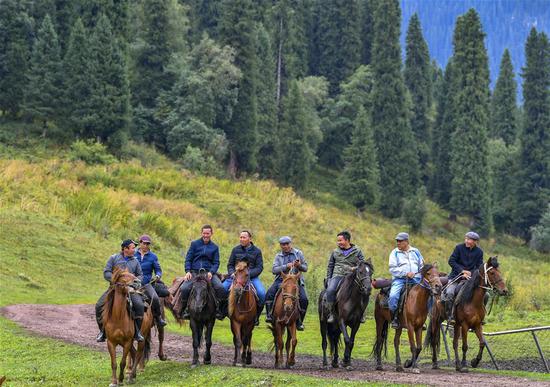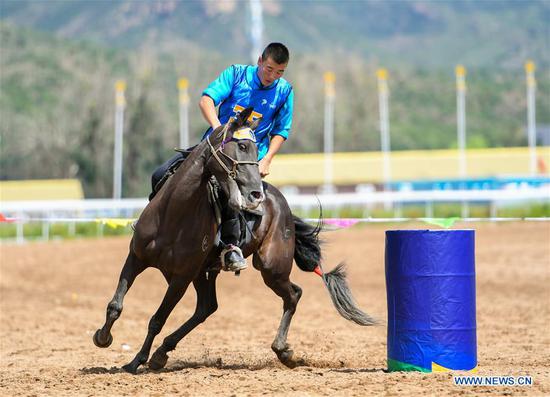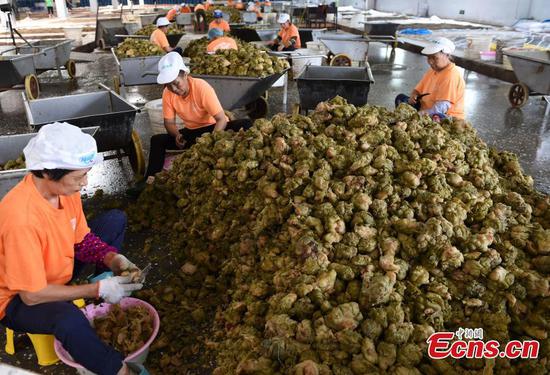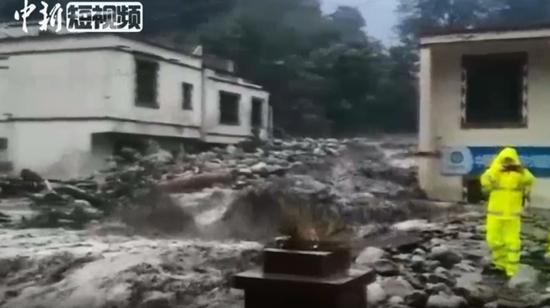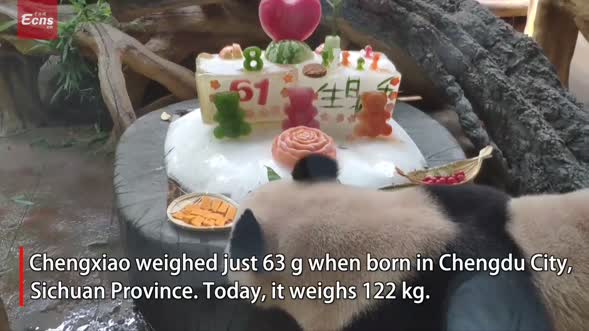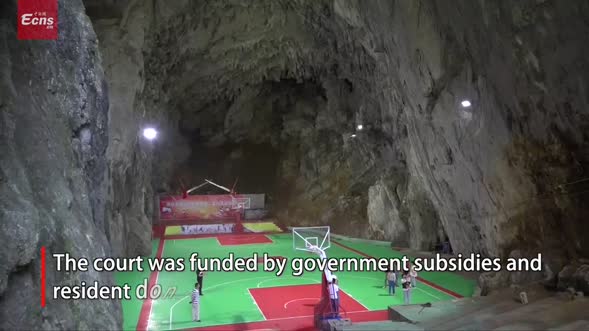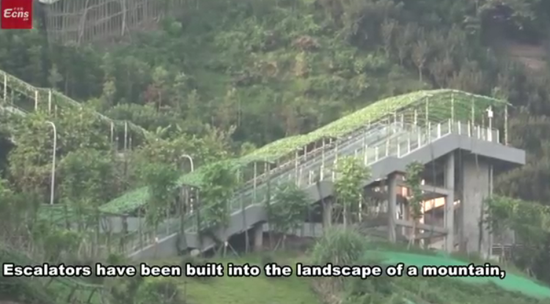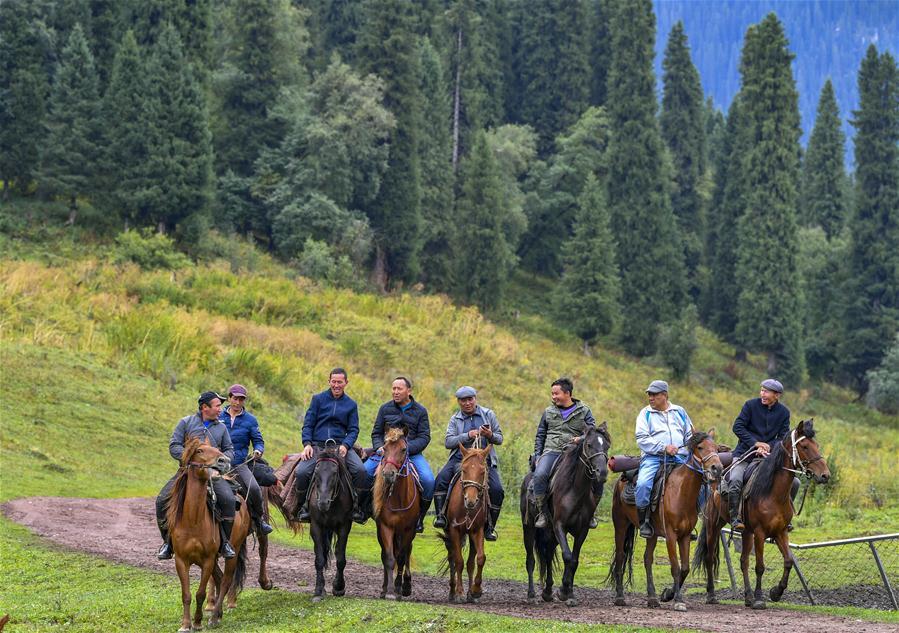
Behtibek Seit (4th R) prepares to patrol on the prairie with his workmates in Agarsin Township of Gongliu County, northwest China's Xinjiang Uygur Autonomous Region, Aug. 16, 2019. Just as the rain stopped, on the cloud-wrapped grassland, Behtibek Seit started daily routine patrolling with his workmates. The prairie manager has been in charge of prairie management and preservation for many years. The 117,000-mu (about 7,800 hectares) prairie is the largest grazing-restricted area in Gongliu County. Every May, prairie managers move in different stations, and they do not go back till November. Each day, they patrol along nearly 30-kilometer routes to prevent livestock from entering the area and also work as a fire lookout. Years pass by, prairie managers' daily patrolling makes the improvement of the ecological environment. Although Behtibek will retire in three years, he will choose to stay with the land if necessary. (Xinhua/Hu Huhu)
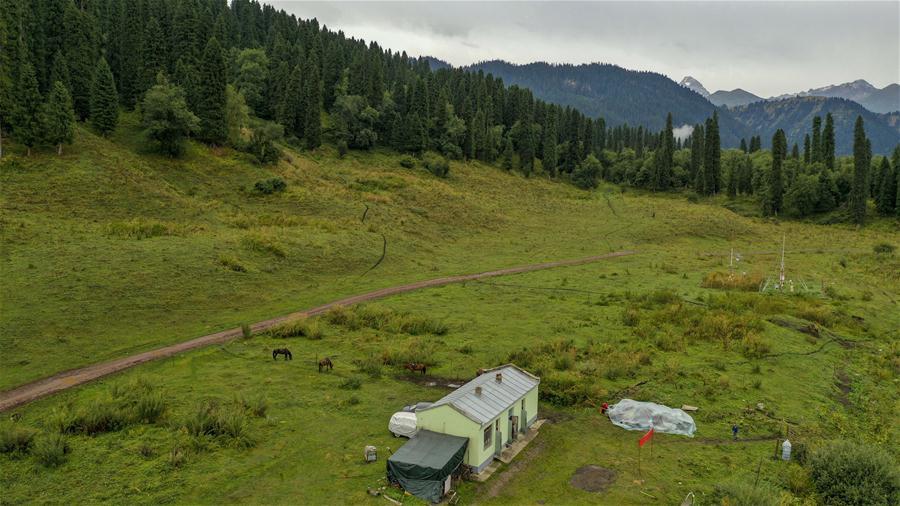
Aerial photo taken on Aug. 16, 2019 shows a stationing spot for prairie managers in Agarsin Township of Gongliu County, northwest China's Xinjiang Uygur Autonomous Region. Just as the rain stopped, on the cloud-wrapped grassland, Behtibek Seit started daily routine patrolling with his workmates. The prairie manager has been in charge of prairie management and preservation for many years. The 117,000-mu (about 7,800 hectares) prairie is the largest grazing-restricted area in Gongliu County. Every May, prairie managers move in different stations, and they do not go back till November. Each day, they patrol along nearly 30-kilometer routes to prevent livestock from entering the area and also work as a fire lookout. Years pass by, prairie managers' daily patrolling makes the improvement of the ecological environment. Although Behtibek will retire in three years, he will choose to stay with the land if necessary. (Xinhua/Hu Huhu)
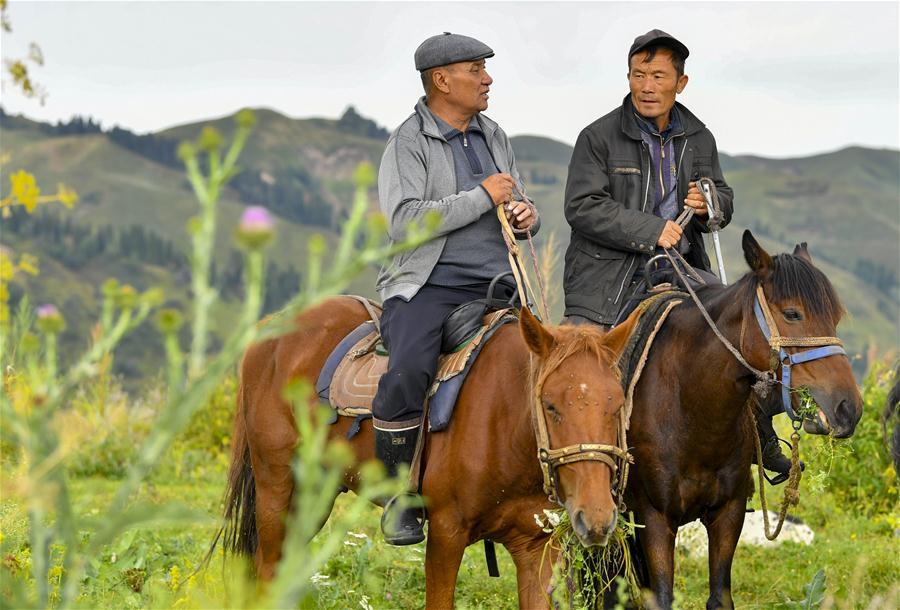
A herdsman (R) asks Behtibek Seit to find a lost drove of horses in Agarsin Township of Gongliu County, northwest China's Xinjiang Uygur Autonomous Region, Aug. 16, 2019. Just as the rain stopped, on the cloud-wrapped grassland, Behtibek Seit started daily routine patrolling with his workmates. The prairie manager has been in charge of prairie management and preservation for many years. The 117,000-mu (about 7,800 hectares) prairie is the largest grazing-restricted area in Gongliu County. Every May, prairie managers move in different stations, and they do not go back till November. Each day, they patrol along nearly 30-kilometer routes to prevent livestock from entering the area and also work as a fire lookout. Years pass by, prairie managers' daily patrolling makes the improvement of the ecological environment. Although Behtibek will retire in three years, he will choose to stay with the land if necessary. (Xinhua/Hu Huhu)

Behtibek Seit (C) gives his workmates tips on patrolling in Agarsin Township of Gongliu County, northwest China's Xinjiang Uygur Autonomous Region, Aug. 16, 2019. Just as the rain stopped, on the cloud-wrapped grassland, Behtibek Seit started daily routine patrolling with his workmates. The prairie manager has been in charge of prairie management and preservation for many years. The 117,000-mu (about 7,800 hectares) prairie is the largest grazing-restricted area in Gongliu County. Every May, prairie managers move in different stations, and they do not go back till November. Each day, they patrol along nearly 30-kilometer routes to prevent livestock from entering the area and also work as a fire lookout. Years pass by, prairie managers' daily patrolling makes the improvement of the ecological environment. Although Behtibek will retire in three years, he will choose to stay with the land if necessary. (Xinhua/Hu Huhu)
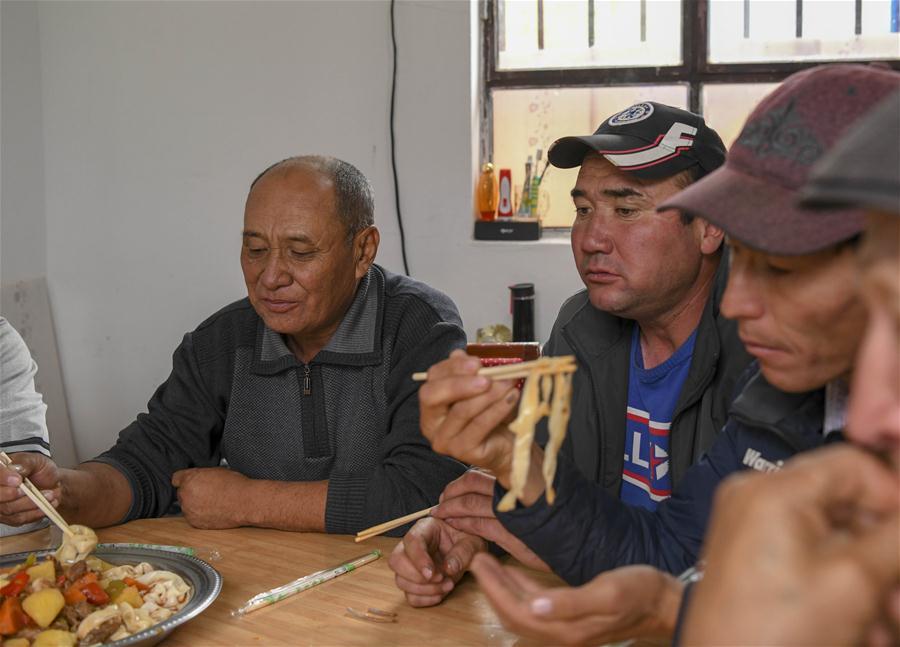
Behtibek Seit (1st L) has meal with his workmates at a station in in Agarsin Township of Gongliu County, northwest China's Xinjiang Uygur Autonomous Region, Aug. 16, 2019. Just as the rain stopped, on the cloud-wrapped grassland, Behtibek Seit started daily routine patrolling with his workmates. The prairie manager has been in charge of prairie management and preservation for many years. The 117,000-mu (about 7,800 hectares) prairie is the largest grazing-restricted area in Gongliu County. Every May, prairie managers move in different stations, and they do not go back till November. Each day, they patrol along nearly 30-kilometer routes to prevent livestock from entering the area and also work as a fire lookout. Years pass by, prairie managers' daily patrolling makes the improvement of the ecological environment. Although Behtibek will retire in three years, he will choose to stay with the land if necessary. (Xinhua/Hu Huhu)
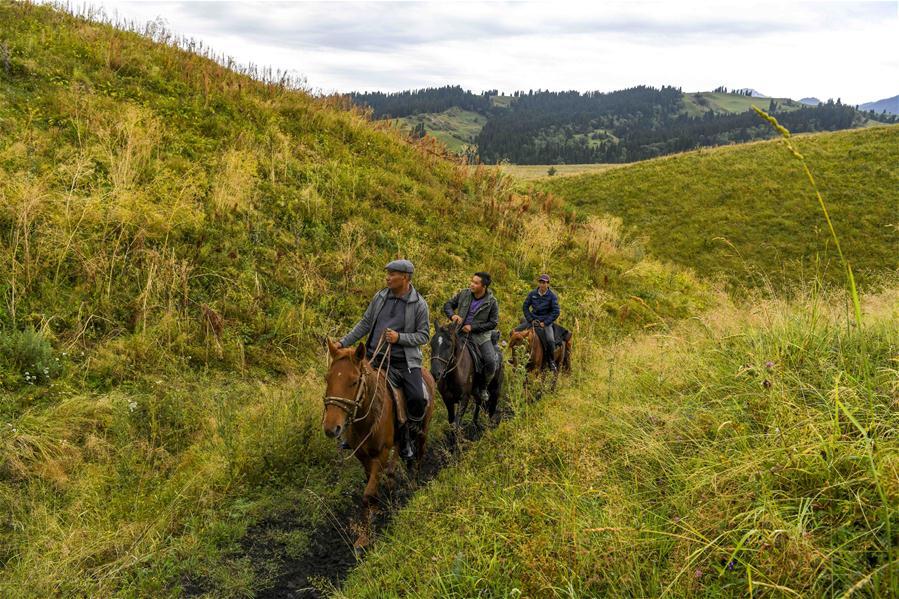
Behtibek Seit (front) patrols on the prairie with his workmates in Agarsin Township of Gongliu County, northwest China's Xinjiang Uygur Autonomous Region, Aug. 16, 2019. Just as the rain stopped, on the cloud-wrapped grassland, Behtibek Seit started daily routine patrolling with his workmates. The prairie manager has been in charge of prairie management and preservation for many years. The 117,000-mu (about 7,800 hectares) prairie is the largest grazing-restricted area in Gongliu County. Every May, prairie managers move in different stations, and they do not go back till November. Each day, they patrol along nearly 30-kilometer routes to prevent livestock from entering the area and also work as a fire lookout. Years pass by, prairie managers' daily patrolling makes the improvement of the ecological environment. Although Behtibek will retire in three years, he will choose to stay with the land if necessary. (Xinhua/Hu Huhu)
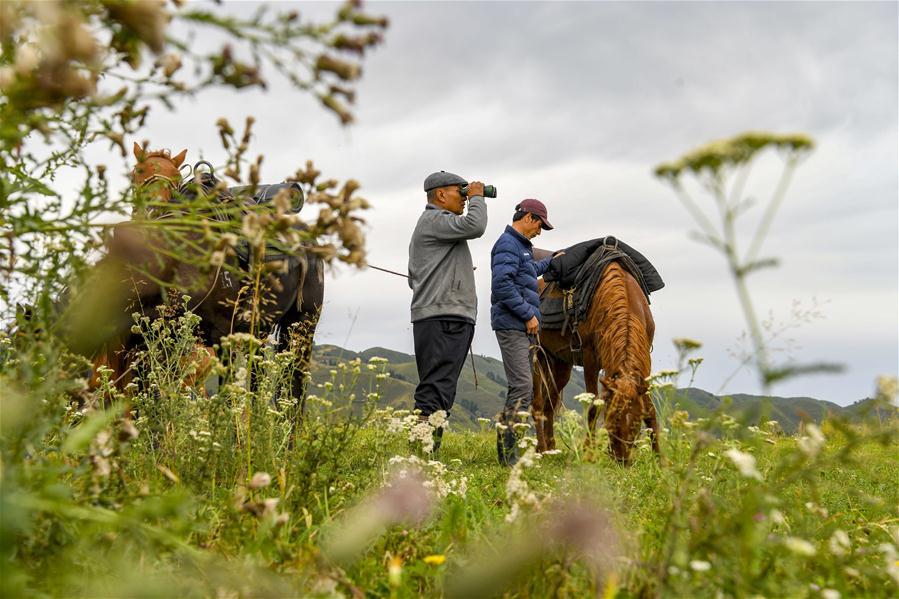
Behtibek Seit (L) patrols on the prairie with his workmate in Agarsin Township of Gongliu County, northwest China's Xinjiang Uygur Autonomous Region, Aug. 16, 2019. Just as the rain stopped, on the cloud-wrapped grassland, Behtibek Seit started daily routine patrolling with his workmates. The prairie manager has been in charge of prairie management and preservation for many years. The 117,000-mu (about 7,800 hectares) prairie is the largest grazing-restricted area in Gongliu County. Every May, prairie managers move in different stations, and they do not go back till November. Each day, they patrol along nearly 30-kilometer routes to prevent livestock from entering the area and also work as a fire lookout. Years pass by, prairie managers' daily patrolling makes the improvement of the ecological environment. Although Behtibek will retire in three years, he will choose to stay with the land if necessary. (Xinhua/Hu Huhu)
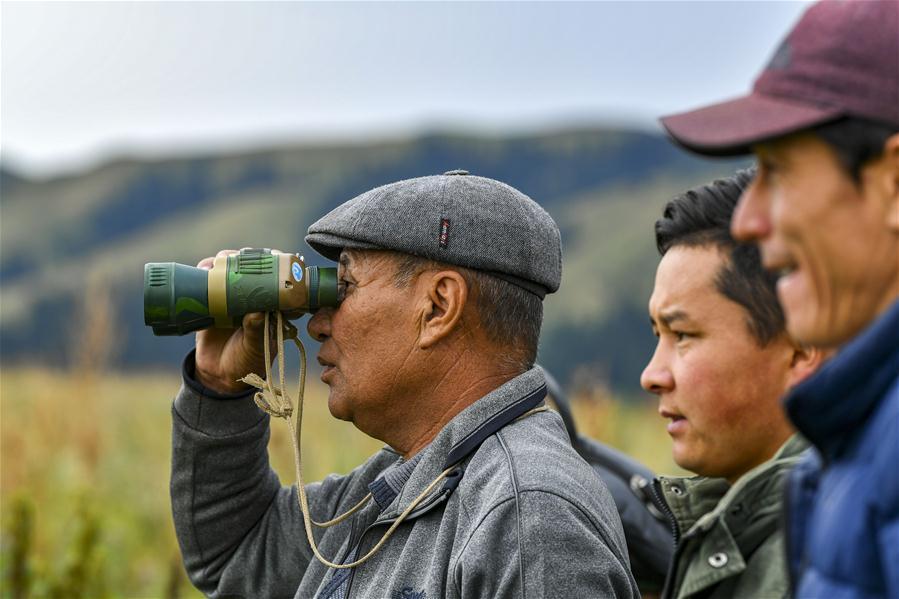
Behtibek Seit (1st, L) observes with a telescope on the prairie in Agarsin Township of Gongliu County, northwest China's Xinjiang Uygur Autonomous Region, Aug. 16, 2019. Just as the rain stopped, on the cloud-wrapped grassland, Behtibek Seit started daily routine patrolling with his workmates. The prairie manager has been in charge of prairie management and preservation for many years. The 117,000-mu (about 7,800 hectares) prairie is the largest grazing-restricted area in Gongliu County. Every May, prairie managers move in different stations, and they do not go back till November. Each day, they patrol along nearly 30-kilometer routes to prevent livestock from entering the area and also work as a fire lookout. Years pass by, prairie managers' daily patrolling makes the improvement of the ecological environment. Although Behtibek will retire in three years, he will choose to stay with the land if necessary. (Xinhua/Hu Huhu)
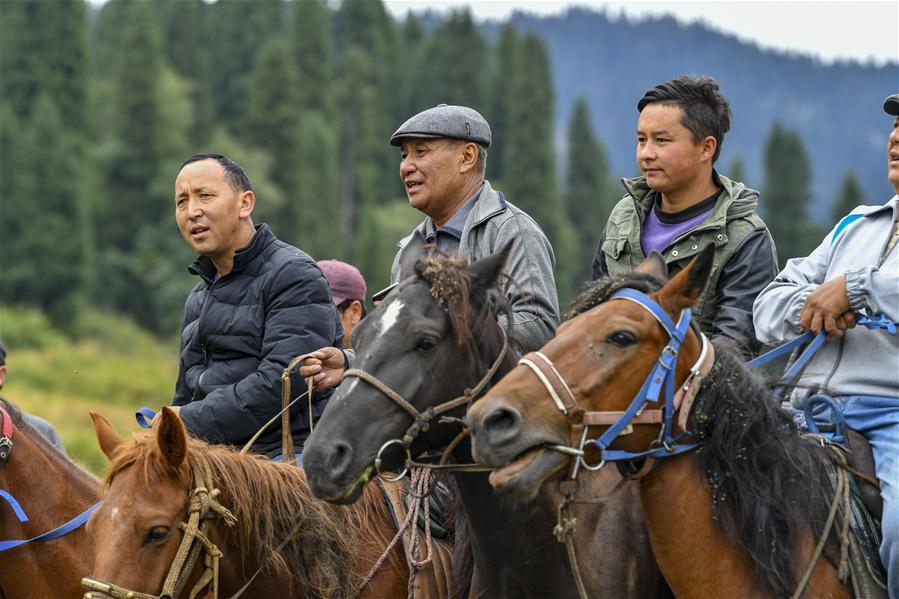
Behtibek Seit (3rd R) patrols on the prairie with his workmates in Agarsin Township of Gongliu County, northwest China's Xinjiang Uygur Autonomous Region, Aug. 16, 2019. Just as the rain stopped, on the cloud-wrapped grassland, Behtibek Seit started daily routine patrolling with his workmates. The prairie manager has been in charge of prairie management and preservation for many years. The 117,000-mu (about 7,800 hectares) prairie is the largest grazing-restricted area in Gongliu County. Every May, prairie managers move in different stations, and they do not go back till November. Each day, they patrol along nearly 30-kilometer routes to prevent livestock from entering the area and also work as a fire lookout. Years pass by, prairie managers' daily patrolling makes the improvement of the ecological environment. Although Behtibek will retire in three years, he will choose to stay with the land if necessary. (Xinhua/Hu Huhu)

Behtibek Seit observes with a telescope on the prairie in Agarsin Township of Gongliu County, northwest China's Xinjiang Uygur Autonomous Region, Aug. 16, 2019. Just as the rain stopped, on the cloud-wrapped grassland, Behtibek Seit started daily routine patrolling with his workmates. The prairie manager has been in charge of prairie management and preservation for many years. The 117,000-mu (about 7,800 hectares) prairie is the largest grazing-restricted area in Gongliu County. Every May, prairie managers move in different stations, and they do not go back till November. Each day, they patrol along nearly 30-kilometer routes to prevent livestock from entering the area and also work as a fire lookout. Years pass by, prairie managers' daily patrolling makes the improvement of the ecological environment. Although Behtibek will retire in three years, he will choose to stay with the land if necessary. (Xinhua/Hu Huhu)
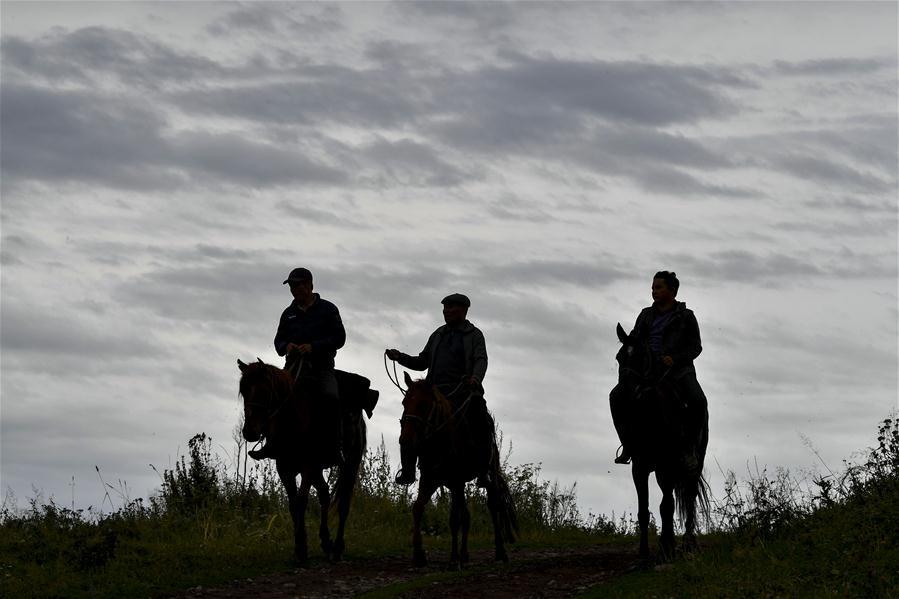
Behtibek Seit (C) patrols on the prairie with his workmates in Agarsin Township of Gongliu County, northwest China's Xinjiang Uygur Autonomous Region, Aug. 16, 2019. Just as the rain stopped, on the cloud-wrapped grassland, Behtibek Seit started daily routine patrolling with his workmates. The prairie manager has been in charge of prairie management and preservation for many years. The 117,000-mu (about 7,800 hectares) prairie is the largest grazing-restricted area in Gongliu County. Every May, prairie managers move in different stations, and they do not go back till November. Each day, they patrol along nearly 30-kilometer routes to prevent livestock from entering the area and also work as a fire lookout. Years pass by, prairie managers' daily patrolling makes the improvement of the ecological environment. Although Behtibek will retire in three years, he will choose to stay with the land if necessary. (Xinhua/Hu Huhu)

